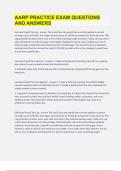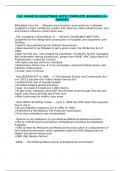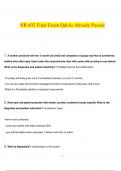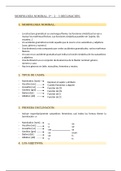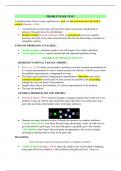AARP PRACTICE EXAM QUESTIONS
AND ANSWERS
Increase Payroll Tax Cap - answer The Social Security payroll tax currently applies to annual
earnings up to $118,500. Any wages earned above $118,500 go untaxed for Social Security. This
cap generally increases every year as the national average wage increases. Today, the cap covers
about 84 percent of total earnings in the nation. Raising the cap to cover a higher percent of
total earnings would help close Social Security's funding gap. This would mean any employee
earning more than the current tax cap of $118,500 (as well as his or her employer) would have
to pay more payroll taxes.
Increase Payroll Tax Cap (Pro) - answer 1. Make Social Security financing more fair by requiring
top earners to pay somewhat more into Social Security
2. Eliminate more than a third (36 percent) of Social Security's projected financing gap over the
long term.
Increase Payroll Tax Cap (Against) - answer 1. Cause a hefty tax increase that will hit middle-
income taxpayers while not affecting the rich. It would especially hurt the self- employed and
certain smaller business owners.
2. In general, increasing taxes is a bad idea. For one thing, it reduces the amount that Americans
have to spend on their own and their family's food, housing clothes, education, and so on.
Additional taxes that seem like a trivial amount to people in Washington may cause real
problems to normal Americans.
Eliminate Payroll Tax Cap - answer The Social Security payroll tax currently applies to annual
earnings up to $118,500. Any wages earned above $118,500 go untaxed for Social Security. This
cap generally increases every year with increases in the national average wage. Today, the cap
covers about 84 percent of total earnings. Eliminating the cap so that all earnings would be
subject to Social Security's payroll tax would help close the program's funding gap. If your
income is under $118,500, you would see no change. If you make above that amount, you (as
well as your employer) would pay the 6.2 percent payroll tax on your remaining wages.
, Eliminate Payroll Tax Cap (Pro) - answer 1. Eliminating the cap on earnings subject to Social
Security taxes would call on top earners to contribute more toward the basic economic security
of the nation's elderly and families, commensurate with top earners' ability to pay.
2. Equalize the duration of Social Security taxes throughout the year, so that the top 6 percent of
earners would pay into Social Security all year long, just as the other 94 percent of workers do.
Eliminate Payroll Tax Cap (Against) - answer 1. Today, a retiree's benefits are based only on the
income on which he or she pays Social Security payroll taxes. Because of this, the maximum
Social Security benefit that even the wealthiest American can receive is just over $30,000 a year.
If millionaires pay Social Security taxes on all of their salary income, the maximum annual
benefit payment could reach over $150,000 a year. This development would not bankrupt the
program, but it would change its nature. Social Security was not intended to provide such large
benefits.
2. It breaks the link between earnings and benefits. So far, a retiree's Social Security benefits
have always been based on the career earnings on which he or she has paid Social Security
taxes. Dropping that principle would open the door to other substantial changes in Social
Security.
Increase Payroll Tax Rate - answer Employers and employees each currently pay a 6.2 percent
tax to Social Security on earnings up to $118,500. Self-employed workers pay both the employer
and employee share, for a total of 12.4 percent. One option to help close the Social Security
funding gap would be to raise the payroll tax rate for all workers and employers. For instance,
on a $50,000 annual salary, increasing the payroll tax rate to 6.45 percent would increase both
the annual employee and employer contribution by $125 each. Changing it to 7.2 percent would
increase the annual employee and employer contribution by $500 each. The rate increase could
occur gradually or all at once. Increasing the payroll tax rate from 6.2 percent to 6.45 percent
immediately is estimated to fill 22 percent of the funding gap. Increasing the payroll tax rate
gradually over 20 years from 6.2 percent to 7.2 percent is estimated to fill 64 percent of the
funding gap.
Increase Payroll Tax Rate (Pro) - answer 1. Social Security does not need additional income now,
but almost certainly will within the next 25 years. Policymakers should act soon to schedule an
increase in the payroll tax rate to take effect in the future when more money will be needed.
2. Policymakers could act now to schedule a gradual rate increase. A gradual increase of 1/20th
of 1 percent each year for 20 years, from 2017 through 2036, would eliminate nearly two- thirds
of the program's projected 75-year shortfall. For an average worker, the additional payment
AND ANSWERS
Increase Payroll Tax Cap - answer The Social Security payroll tax currently applies to annual
earnings up to $118,500. Any wages earned above $118,500 go untaxed for Social Security. This
cap generally increases every year as the national average wage increases. Today, the cap covers
about 84 percent of total earnings in the nation. Raising the cap to cover a higher percent of
total earnings would help close Social Security's funding gap. This would mean any employee
earning more than the current tax cap of $118,500 (as well as his or her employer) would have
to pay more payroll taxes.
Increase Payroll Tax Cap (Pro) - answer 1. Make Social Security financing more fair by requiring
top earners to pay somewhat more into Social Security
2. Eliminate more than a third (36 percent) of Social Security's projected financing gap over the
long term.
Increase Payroll Tax Cap (Against) - answer 1. Cause a hefty tax increase that will hit middle-
income taxpayers while not affecting the rich. It would especially hurt the self- employed and
certain smaller business owners.
2. In general, increasing taxes is a bad idea. For one thing, it reduces the amount that Americans
have to spend on their own and their family's food, housing clothes, education, and so on.
Additional taxes that seem like a trivial amount to people in Washington may cause real
problems to normal Americans.
Eliminate Payroll Tax Cap - answer The Social Security payroll tax currently applies to annual
earnings up to $118,500. Any wages earned above $118,500 go untaxed for Social Security. This
cap generally increases every year with increases in the national average wage. Today, the cap
covers about 84 percent of total earnings. Eliminating the cap so that all earnings would be
subject to Social Security's payroll tax would help close the program's funding gap. If your
income is under $118,500, you would see no change. If you make above that amount, you (as
well as your employer) would pay the 6.2 percent payroll tax on your remaining wages.
, Eliminate Payroll Tax Cap (Pro) - answer 1. Eliminating the cap on earnings subject to Social
Security taxes would call on top earners to contribute more toward the basic economic security
of the nation's elderly and families, commensurate with top earners' ability to pay.
2. Equalize the duration of Social Security taxes throughout the year, so that the top 6 percent of
earners would pay into Social Security all year long, just as the other 94 percent of workers do.
Eliminate Payroll Tax Cap (Against) - answer 1. Today, a retiree's benefits are based only on the
income on which he or she pays Social Security payroll taxes. Because of this, the maximum
Social Security benefit that even the wealthiest American can receive is just over $30,000 a year.
If millionaires pay Social Security taxes on all of their salary income, the maximum annual
benefit payment could reach over $150,000 a year. This development would not bankrupt the
program, but it would change its nature. Social Security was not intended to provide such large
benefits.
2. It breaks the link between earnings and benefits. So far, a retiree's Social Security benefits
have always been based on the career earnings on which he or she has paid Social Security
taxes. Dropping that principle would open the door to other substantial changes in Social
Security.
Increase Payroll Tax Rate - answer Employers and employees each currently pay a 6.2 percent
tax to Social Security on earnings up to $118,500. Self-employed workers pay both the employer
and employee share, for a total of 12.4 percent. One option to help close the Social Security
funding gap would be to raise the payroll tax rate for all workers and employers. For instance,
on a $50,000 annual salary, increasing the payroll tax rate to 6.45 percent would increase both
the annual employee and employer contribution by $125 each. Changing it to 7.2 percent would
increase the annual employee and employer contribution by $500 each. The rate increase could
occur gradually or all at once. Increasing the payroll tax rate from 6.2 percent to 6.45 percent
immediately is estimated to fill 22 percent of the funding gap. Increasing the payroll tax rate
gradually over 20 years from 6.2 percent to 7.2 percent is estimated to fill 64 percent of the
funding gap.
Increase Payroll Tax Rate (Pro) - answer 1. Social Security does not need additional income now,
but almost certainly will within the next 25 years. Policymakers should act soon to schedule an
increase in the payroll tax rate to take effect in the future when more money will be needed.
2. Policymakers could act now to schedule a gradual rate increase. A gradual increase of 1/20th
of 1 percent each year for 20 years, from 2017 through 2036, would eliminate nearly two- thirds
of the program's projected 75-year shortfall. For an average worker, the additional payment

